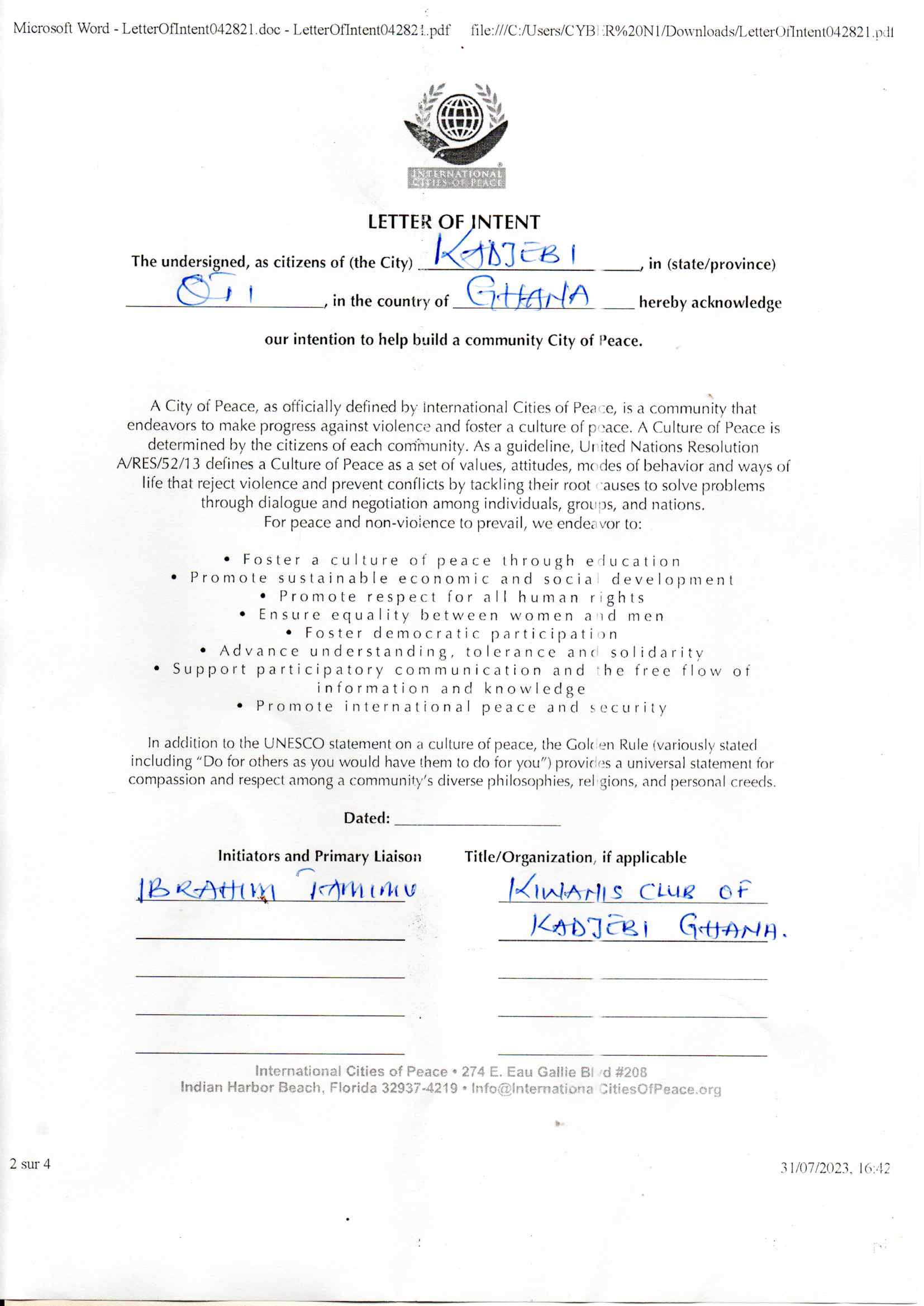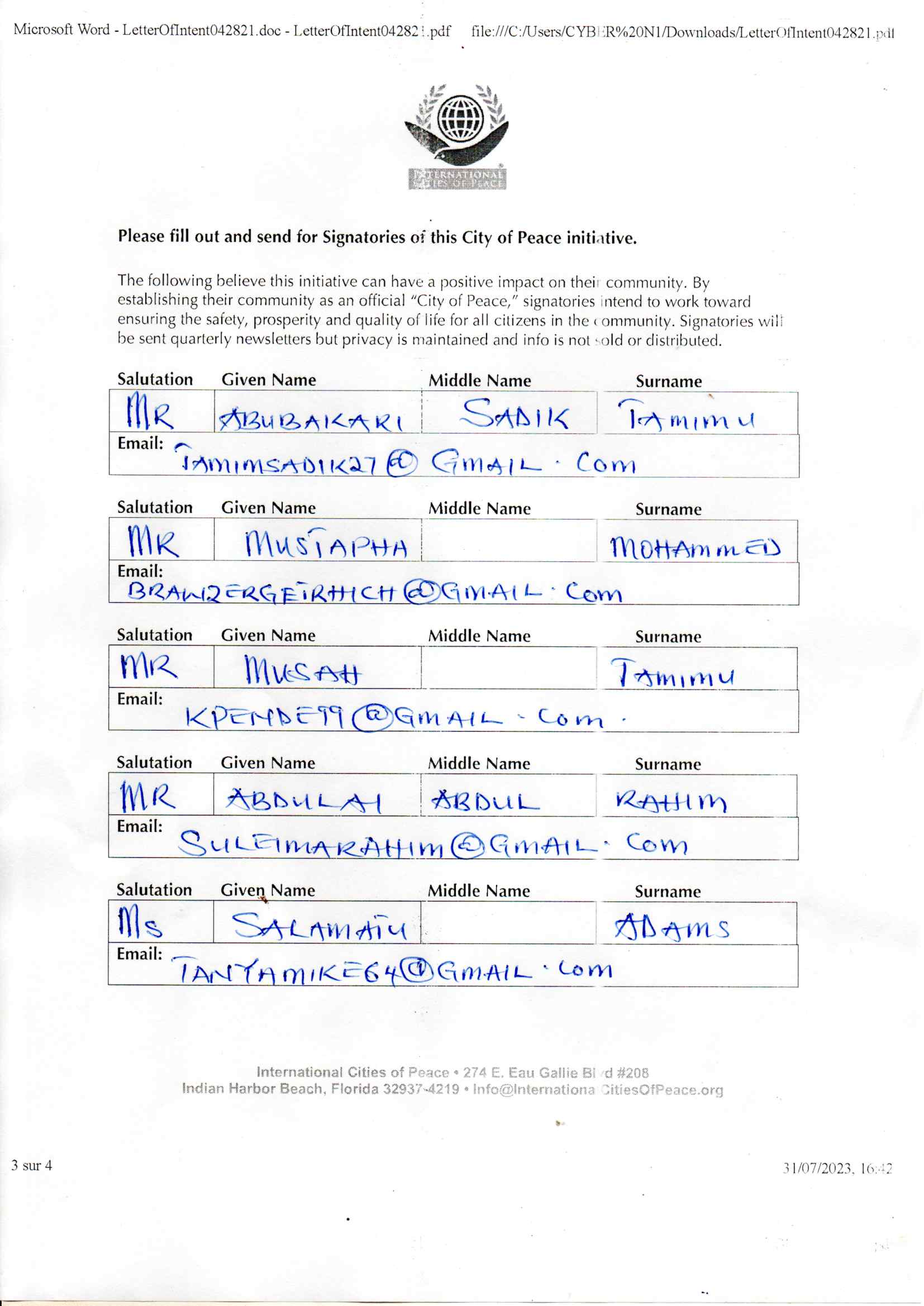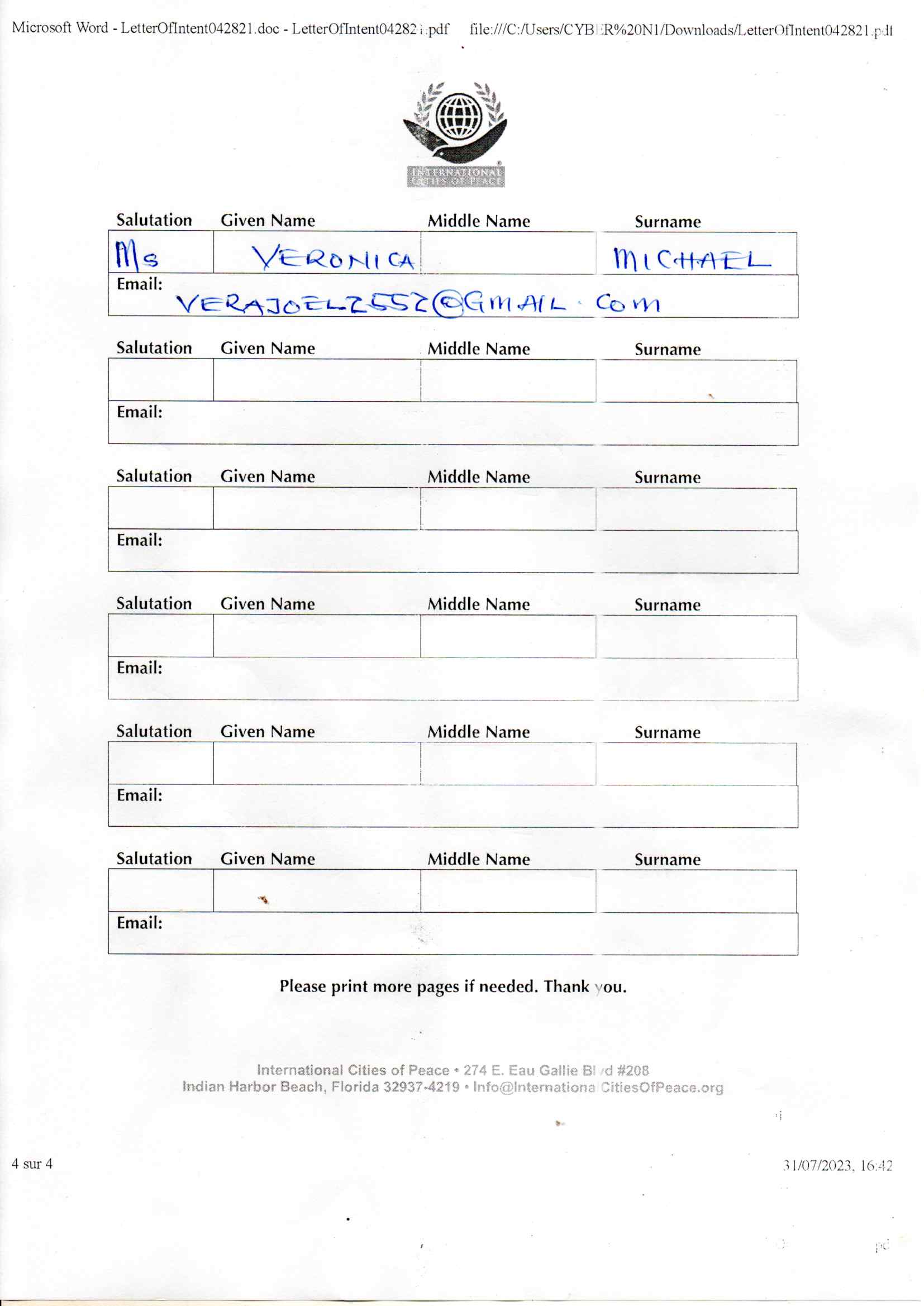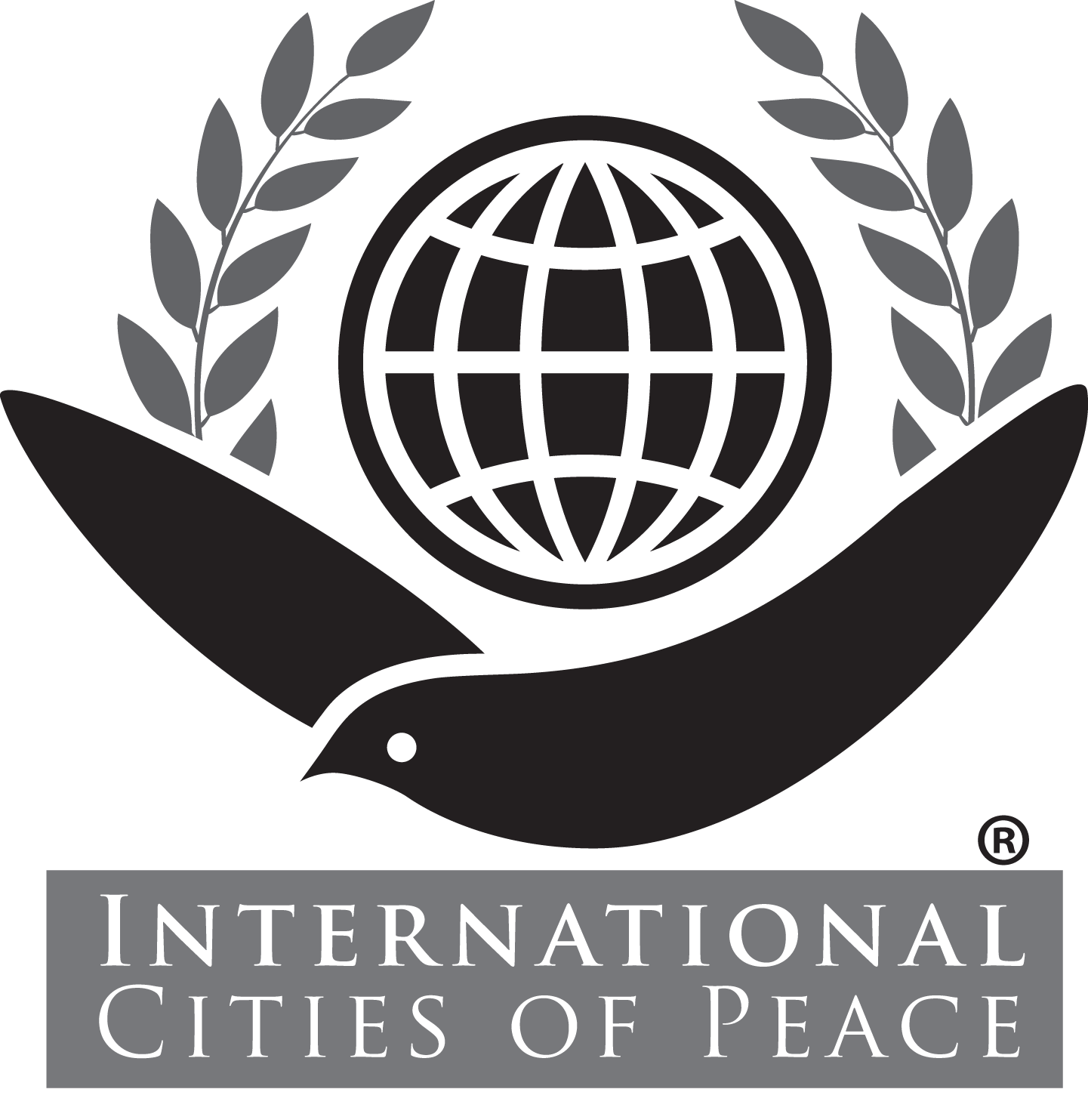Kadjebi, Oti region, ghana: International City of Peace
We welcome Ibrahim Tamimu and his colleagues who have established the town of Kadjebi in the Oti Region of Ghana as an International City of Peace.
KADJEBI was initially part of the Jasikan District until it was created in 1989 with its capital Kadjebi which took over the initial name of Akan District to present Kadjebi District. The district comprises eight (8) traditional areas, that are Kadjebi, Asato, Ahamansu, Dodo, Ampeyo, Pampawie, Dappa and Papase respectively and they speak twi as their local language.
Note: Introduction page with information primarily at the time of joining International Cities of Peace. For updates, please contact the liaison.
ABOUT THE INITIATIVE
VISION
Ultimately, our vision is a future where the world comes together as a family, united by our shared humanity, and we embrace peace as the guiding principle in all our endeavors. We are dedicated to leaving a legacy of hope, love, and understanding for generations to come, inspiring others to join the path of peace and make the world a better place for everyone.

MISSION
Promoting and enhancing the capacity of children, youth and women in Kadjebi to effect positive social change that would necessitate the development of their lives, communities, nation and also, maintaining peace in the community.
GOAL
We are working towards healing and rebuilding relationships between conflicting parties, encouraging forgiveness and understanding. We again strive to raise awareness about the impact of conflict and violence on communities, fostering empathy and understanding among the broader population.

FESTIVALS AND CEREMONIES
1. AKWASIDAE KESIE:
This festival is celebrated by the Akans every year in the District. The festival is been counted and celebrated on Sunday, the last forty-two (42) days before the end of the year. On the eve of this festival the chiefs and people of every traditional areas meet at the chief’s palace to commence the celebration, where libation is poured by the chief linguist and those to special occasion are Frontonfrom, Kete, Adowa, Osite dance are performed till midnight to end the first part. This is in the remembrance of the ancestors who lost their lives in wars and the attire is mourning clothes only.

2. DAWURO KESE FESTIVAL:
This festival is for the people of Kedjebi as traditional festival which has a story of cultural heritage and environment. The people of Kadjebi were pushed by wars acrossed the Volta river our 300 years ago and finally settled at mountain Karikera (pronounce as “Kera”east of present Kadjebi) and angry at the preservation of her glory through neglect and pollution (allegedly by adversaries) only stream running through the town caused an epidemic.
The populace dwindled and the enemies took advantage of reducing the population to harass its people. Then, Nana Akompi, the chief in consultation with an oracle at that time caused a big gong-gong “dawurokese” to be made. The gong-gong was said to have mesmersing and demoralizing effect on the enemies.
It was instructed that spiritual and physical cleaning should be carried out each year, the women of Kadjebi swept the town with a special leaf shouting in the process “Yere pan yade” meaning to away sickness as a form of Passover. The relevance and success of Dawurokese today is due to its capture of the past traditional values and modern requirement, environmental issues are threatening today, therefore, the forest and rivers must be preserved. The theme for Dawurokese festival appropriately selected is based on judicious use of the forest and streams.
This festival is celebrated in very three (3) years by the people of Kadjebi in remembrance of the ancestors of the area.

3. MARRIAGE CEREMONY
In the Kadjebi District, all the eight (8) traditional areas, that is Kadjebi, Asato, Ahamansu, Dodo, Ampeyoo, Pampawie, Dapaa and Papase, they all practiced the Akan type of marriage ceremony.
For example, when the two couple met and agreed for marriage, the man would inform the parents about the acceptance of the woman for marriage. A woman would be sent to the woman’ parents for the release of their daughter for marriage to their son. And this would continue for three (3) consecutive times. The woman’s parents would also call their daughter and deliver the message to her and when accepted, a day would be fixed for the ceremony. The chiefs and elders and relatives and other people would assemble at the head of the woman’s family house for the ceremony.
Seven pots of palm wine, one native mat, red band and an amount in envelop would be provided for the rites.
One pot of palm wine would be given to the man’s friend to be shared among the youths who help the man in the marriage activities. The remaining six post would be poured in one big pot. The elder of the family would pour libation and an elderly woman would also pour hers. They would ask the ancestors and God’s guidance for a successful marriage.
The rest of the drink would be shared among the gathering. The chiefs and elders would advice the couples on how to live peacefully in their marriage home. Both families would thank the chiefs and people present for their response to the success of the ceremony.
4. OUTDOORING OF NEW BORN BABIES
Outdooring of babies is held on the 8th day after the baby was born. The parents of the baby would invite the chief, elders and people concerned of the town to grace the occasion. The naming ceremony is done at the head of the family’s house at 5:30am, when libation would be poured for god’s protection and a name would be given to the new born baby.
As custom demands a little drop of drink, water and salt would be dropped in the mouth of the baby. This signifies that the baby when grown would drink water, eat salt and drink any kind of drink of choice. Then donations would be made to the child either in cash or kind.
LETTER OF INTENT with signatures



ABOUT THE LIAISON
IBRAHIM TAMIMU
Student (International Relation & diplomacy)
Practice group: Cambridge International College
I am Ibrahim Tamimu by name. I am 25 years of age and will be 26 in December, I am 6 ft tall and 180 lbs. I am a football referee and also, a student of Cambridge International College, studying International Relation and Diplomacy. I am in my 2nd year and soon to complete. Talking about who I am, I am that easy going type , adventurous, energetic and ready to give back to my community to bring smile in the faces of kids and adults.

My hobbies are too many but not to mentioned few ; sports, watching of movies, reading books and also making research. I also make sure to share the little that I have with someone and also satisfy with whatever I have.
I would be happy to work with you as peace Liaison in my community. Peace has been what have dreamt of bringing in my community but I am just waiting for the little opportunity to come, and this is the time.
CONTACT INFORMATION
To contact or support this initiative:
ABOUT GHANA (from Wikipedia)
Ghana, officially the Republic of Ghana, is a country in West Africa. It abuts the Gulf of Guinea and the Atlantic Ocean to the south, sharing borders with Ivory Coast in the west, Burkina Faso in the north, and Togo in the east. Ghana covers an area of 238,535 km2 (92,099 sq mi), spanning diverse biomes that range from coastal savannas to tropical rainforests. With over 32 million inhabitants, Ghana is the second-most populous country in West Africa, after Nigeria. The capital and largest city is Accra; other major cities are Kumasi, Tamale, and Sekondi-Takoradi.
Note: If information or photos used here are copyrighted, please contact us and we will immediately delete the copyrighted material.

